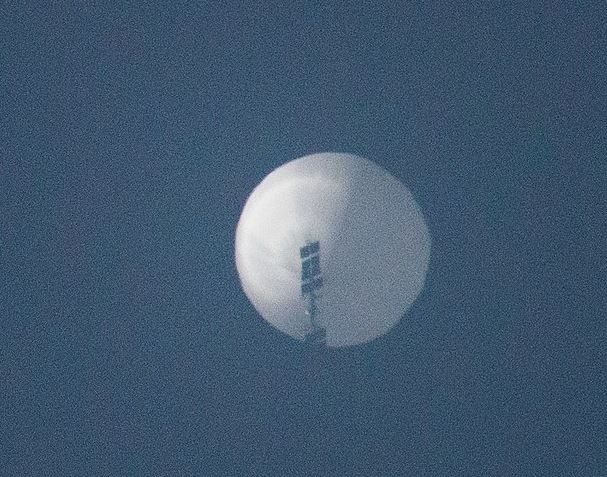by Julia Tong
On Jan. 23, 2023, a balloon from Henan, China floated into US airspace, sparking a media firestorm that strained tensions between the US and China. The “Chinese Spy Balloon” became one of the most prominent stories of 2023.
What was less discussed, however, were later revelations that the balloon was not spying for the Chinese government. A year after the spy balloon incident, Asian American groups say it has only heightened xenophobia, prejudices, and fear around the AAPI community.
“The alleged spy balloon was contributing towards… perceptions that Chinese and Chinese Americans and Asian Americans and immigrants writ large should be considered a suspicious class,” says Cynthia Choi, co-director for Chinese for Affirmative Action.
“There was no intelligence collection by that balloon”
When the Chinese balloon crossed into US aerospace, American officials immediately claimed that it was conducting espionage. The resulting controversy immediately raised hostilities towards China, with Secretary of State Anthony Blinken even canceling a diplomatic trip to the nation. Chinese officials, however, vehemently denied accusations of spying, maintaining that the balloon was research equipment that veered off course.
The balloon was ultimately shot down on February 4th. In the days after its wreckage was recovered, US officials released a statement that the balloon was “clearly for intelligence surveillance.”
But after months of analysis, officials quietly walked back those claims.
In September, a spokesperson from the Pentagon announced that the balloon did not collect information while transiting over the US. This was echoed by high-ranking officials like the chairman of the Joint Chief of Staff, Mark Milley.
“The intelligence community, their assessment – and it’s a high-confidence assessment – [is] that there was no intelligence collection by that balloon,” said Milley.
But the damage was done. Asian American advocacy groups say the spy balloon controversy enflamed existing prejudices against Asian Americans– specifically Chinese Americans and immigrants– setting the stage for future discrimination.
Choi says that she was “very concern[ed]” by media and officials naming the balloon as the “Chinese Spy Balloon.” This name affirmed to the public that the balloon was conducting espionage— despite no investigation confirming that fact.
The “Chinese spy balloon” label reminded Choi of initial reactions to the COVID-19 virus, which some politicians referred to as the “Wuhan virus” and “China virus.” Both stoked Sinophobia against Asian communities.
“It’s irresponsible for the media, it’s irresponsible for elected officials to jump to conclusions,” she says.
Disturbingly, Choi observes, the language used around the balloon echoed other Sinophobic rhetoric, such as politicians referring to COVID-19 as the “Wuhan virus” and the “China virus.”
“It does create a contributing toward, again, this broader narrative that Chinese Americans and other immigrants are not to be trusted,” she said.
Compounding this issue, the media did not cover the US confirmation that the balloon was not engaging in espionage with the same intensity as the “Chinese spy balloon” story. As a result, public opinion incorrectly remains that the balloon was indeed a “spy balloon.”
The consequence, Choi says, is the lasting damage to the Asian American community at large.
“Since that time, we’ve seen this sense of being fearful of Chinese people writ large,” she adds.
An “accumulating, stigmatizing effect”
The Sinophobia engendered by the spy balloon controversy also had tangible consequences. Jeremy Wu, co-organizer of APA Justice, tracks discriminatory legislation currently targeting Asian Americans across the nation. The most notable of those are the 33 alien land laws, preventing Chinese Americans from owning property in a state, which have recently been introduced across the country.
Though the spy balloon controversy did not cause these laws, Wu says it had an “accumulating, stigmatizing effect” that set the stage for them to happen.
“Although the ‘spy balloon’ was not spying, the incident has been intentionally and unintentionally used as a national security risk to justify the new alien land laws,” Wu wrote to AsAmNews. “While not discounting that there are real national security risks, the ‘spy balloon’ plays into xenophobia and racism.”
But Wu also situates the spy balloon as a “footnote” in historic and ongoing anti-Asian racism. One example is the Wen Ho Lee case in 1999, where a Taiwanese American scientist Wen Ho Lee was falsely charged for espionage, sparking a similar media firestorm around Chinese spying.
But the history of this racism is unknown to many. Today, Wu observes, there is less knowledge of the case among young Asian Americans. Similarly, few Americans are aware that the “spy balloon” did not conduct espionage. More education, he says, is necessary to combat this lack of awareness.
“The Asian American communities are courageous and resilient in their fight and advocacy from generation to generation,” writes Wu. “Education through books, stories, schools, museums, monuments, and other means is essential to carry this struggle on and maintain hope for meaningful change.”
And other community organizations, meanwhile, are educating their communities to push back against ongoing anti-Asian rhetoric. For instance, Chinese for Affirmative Action and Stop AAPI Hate launched the Stop the Blame Campaign, which aims to hold elected officials accountable for racist rhetoric.
But Choi says the campaign’s goal is also to educate and mobilize communities to respond to those political tactics. And she is optimistic that greater awareness within the community will help Asian Americans push back on the next wave of fear and discrimination that rhetoric can bring.
“This type of anti-Chinese, anti Asian, anti-immigrant climate, this kind of fearmongering, creates a lot of legitimate fears in this country,” she says. “And that’s something that we are prepared to challenge.”
AsAmNews is published by the non-profit, Asian American Media Inc. Thank you for all who supported our year-end fundraising drive. Donations are still being accepted through this link. We are supported in part by funding provided by the State of California, administered by the California State Library in partnership with the California Department of Social Services and the California Commission on Asian and Pacific Islander American Affairs as part of the Stop the Hate program. To report a hate incident or hate crime and get support, go to CA vs Hate.



OMG, early in 2023 a drifting Chinese balloon was collecting intelligence as it drifted over the U.S.
Of course, anyone using a balloon to overfly Alaska and several other states, especially over Air Force bases, was attempting to gather intelligence. While this is disturbing, China’s airborne intelligence gathering is quite trivial, compared to the efforts of others. This drifting balloon attempted to use public internet to communicate to China. If it did, the information communicated would be accessible to our government.
One issue was never mentioned, the Chinese now have several dozen space satellites, part of their Beidou 3 system, and they must surely be taking photos of American military bases all over the world. An out of control balloon, even though flying over America should be of limited value.
Since the late 1950s, high flying platforms have been overflying many countries, including the then Soviet Union, China, N. Korea, Cuba and Vietnam. These surveillance platforms were U-2 aircraft, managed by the CIA and flown by our Air Force pilots who were reserve officers who had to become civilians , sometimes foreign pilots, including Taiwanese Air Force pilots.
In 1960 Francis Gary Powers was shot down in the Soviet Union which was a big deal at the time.
The U-2 story is quite unusual and exciting, click on the Lockheed U-2 – Wikipedia,
https://en.wikipedia.org/wiki/Lockheed_U-2